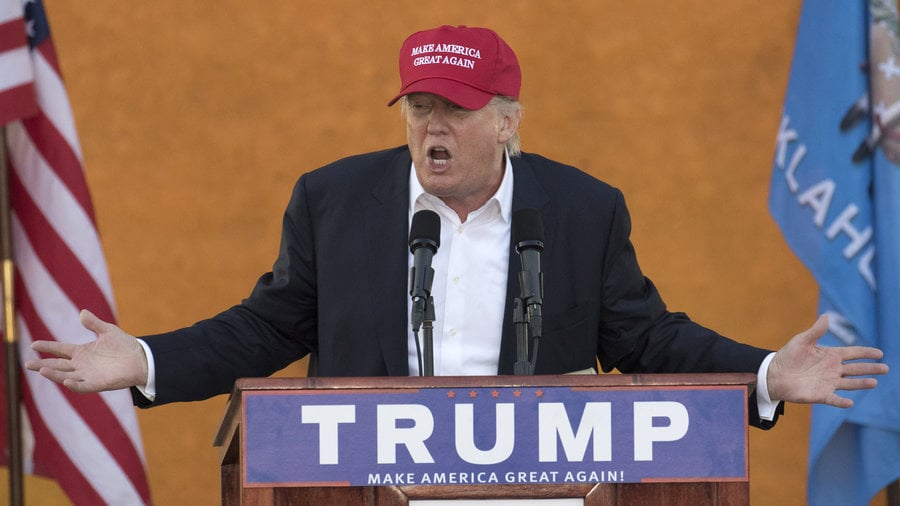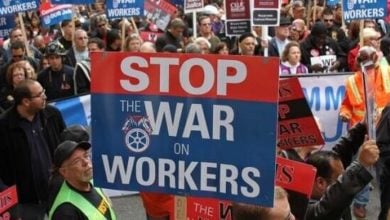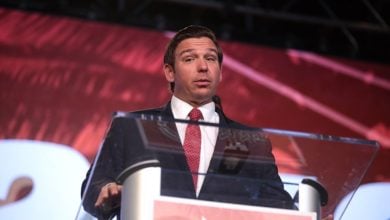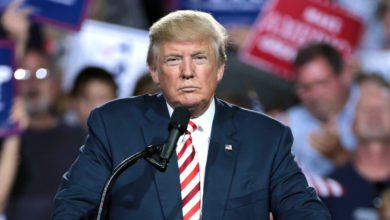The Party for Socialism and Liberation is running Gloria La Riva for President and Eugene Puryear for Vice-President in the 2016 election. View the campaign’s 10-point program and short candidate biographies here.
Anyone with the slightest progressive inclination was surely disgusted by last week’s Republican presidential primary debate. The candidates competed to outdo one another with over-the-top sexism, anti-trans bigotry, militarism and contempt for poor and working people. The Democratic Party is loyal to the same capitalist system of exploitation and oppression—the Republicans are their cousins who don’t want to bother covering it up.
That the Republican Party is hostile to the rights of working and oppressed people is not news. The debate did, however, highlight an important political trend that has the potential to reshape the political landscape of the United States—serious disunity within the right wing.
Thursday’s debate took place on a very crowded stage, but the 10 candidates present are not the only hopefuls for the Republican nomination. A whole other debate had to be held earlier in the day to accommodate the seven other contenders who are at the bottom of the opinion polls. This huge number of candidates is a reflection of the diverging currents within the party.
A divided Republican Party
Since Goldwater and Nixon’s “Southern Strategy” of the mid-1960s, the path to electoral victory for the Republican Party had been more or less clear: Energize white voters with thinly-veiled racism, consolidate white men with sexist positions like opposition to abortion rights, and retain a sizable share of white women on the basis of racist and anti-LGBTQ bigotry. This has failed in the last two elections, and the more far-sighted elements of the Republican leadership understand that it is unlikely to work again.
In 1980, when the Republican Party won perhaps its most crushing victory with Ronald Reagan, whites made up 88 percent of the electorate, and oppressed nationalities just 12, but in 2012 the gap narrowed to 72-28. Demographic trends are not in the Republicans’ favor. By the end of the decade, whites will no longer make up the majority of people under the age of 18. The Republican base is aging, and majorities of young people, who have suffered greatly in this latest stage of capitalist crisis, consistently favor progressive positions in opinion polls.
To stay competitive at the national level in the long run, top Republican strategists understand that they need to develop a base of support among Latinos—much larger than the dismal 27 percent support Mitt Romney received—and if possible other oppressed communities as well. To do this, the party must soften its dog whistle rhetoric and walk back its most hard-right positions. This was laid out in the “Growth and Opportunity Project” report, a post-mortem on the Romney campaign released in 2013 by the Republican National Committee.
The dilemma, however, is that this is anathema to the base of white racists the Republican Party has so carefully cultivated over the decades. This existential question, as well as the declining fortunes of the U.S. ruling class as a whole, has led to the emergence of serious divisions amongst Republicans.
The dominant grouping in the party, often referred to as the “establishment” wing, largely favors efforts to broaden its electoral support and move away from the far right. The base of this faction are some of the most powerful sections of capital—energy monopolies, weapons manufacturers and finance, among others. It is the most well-resourced, but has the hardest time mobilizing an enthusiastic following among the Republican rank-and-file.
Jeb Bush is the leading representative of this camp and is polling second behind Donald Trump (often in a statistical tie with notorious anti-union Wisconsin governor Scott Walker). Bush raised over $100 million in the first six months of this year, a record haul that puts him well ahead of all of his rivals in terms of fundraising. Marco Rubio and Scott Walker are also seriously vying for the support of establishment Republicans, and Chris Christie is desperately trying to regain his standing as the favorite of this current.
The Tea Party
The Tea Party faction derides the establishment as part of “Washington big government” and advocates a sharp turn to the right. The Tea Party burst onto the political scene in 2009, spewing vicious racism directed at the first Black president and expressing deep anxiety over the 2008 world economic collapse. The base of the Tea Party is the white “middle class”—small business owners, professionals and upper strata workers, who lead comfortable lives but are insecure about the future. It is backed by disaffected sections of mainly industrial (as opposed to finance) capital, such as the Koch brothers, and at times takes on characteristics of a mass movement.
The Tea Party was initially very useful to the Republican leadership and the ruling class generally. It took up the political space that could otherwise have been filled by a progressive challenge to the system at a time of extreme instability for world capitalism, and injected fresh energy into the Republican Party after the loss in the 2008 election, propelling the party to victory in the 2010 midterms. However, the divergence in class interests has now turned the Tea Party into a serious headache for the establishment wing.
For those at the heights of monopoly capital, massive government assistance is a non-partisan necessity, as is a functional Congress that is at least on speaking terms with the president. However, for smaller capitalists and whites in the middle class, this only serves to entrench the competitive edge of the big monopolies. The first big clashes between the Tea Party and the establishment came over the threat of a “government shutdown” during the debt ceiling and “fiscal cliff” dramas that led to huge anti-worker budget cuts.
The latest showdown was over the Export-Import Bank, which gives out loan guarantees to subsidize large corporations’ overseas activities. In the end, Tea Party Republicans managed to block its reauthorization, causing great frustration among the main sections of capital. Threatening to lay off thousands of workers, Boeing Chairman James McNerney lamented, “I am more worried about it [Congress] today than I ever have been. I’ve always had a view that sanity would prevail on issues of pragmatism. It’s a sign of dysfunctionality of this town [Washington, D.C.] now.”
Ted Cruz has long been considered the Tea Party champion in the Republican primary, although his momentum has taken a hit from the ascent of the Trump campaign. Ben Carson is another serious Tea Party contender, while Rand Paul, Scott Walker and Bobby Jindal are also making overtures to this faction.
Rand Paul is the main candidate to identify with the Republicans’ libertarian wing, which has a similar social base as the Tea Party but is more ideologically grounded and less visceral. His campaign has stumbled as he attempted to widen his appeal to too many disparate currents within the party. Mike Huckabee and Rick Santorum are basing their campaign on the Christian right wing, which once filled the role of quasi-mass movement but has seen its influence wane since the Tea Party took over that position.
Donald Trump
These fault lines existed prior to the current campaign cycle and have been exacerbated by the deepening electoral dilemma facing the Republican Party. Donald Trump is the unwelcome surprise adding another layer of chaos to this bitter strategic debate. For the moment, he is the front-runner and seemingly bulletproof.
His racist attack on Mexican immigrants in his kick-off speech was considered to have gone too far even by Republican standards, but it catapulted him to the top of the opinion polls. His claim that John McCain is not a war hero is blasphemy in bourgeois politics, but his poll numbers simply went up. In light of this, it is unlikely that his sexist feud with Fox News anchor Megyn Kelly will stunt his momentum.
Trump’s miscalculated statements, as well as his complete lack of specific policy proposals, are not a problem for his growing base of supporters because the most appealing part of his campaign is what is left unsaid. Trump’s tirades against political correctness, immigrants, women and “losers” are understood for their true meaning—a promise to roll back any progressive change of recent decades and return to an era of unquestioned dominance of white men. This will make the United States “strong” enough to weather unfavorable economic and geopolitical headwinds and impose once again its unrivaled domination over the world.
As was highlighted in the debate, Trump is unwilling to rule out an independent run for president if he is treated “unfairly.” He has the financial resources to back up that threat, and for that reason the leadership of the Republican Party and its most prominent donors have not yet made any serious moves to derail or disqualify Trump. Should Trump continue to dominate opinion polls leading into the early stages of primary voting, they may have no choice but to make efforts to whittle down the field so that one candidate emerges as the anti-Trump—a highly risky maneuver, since the stakes are defined by the ambitions of top-tier career politicians.
No good options
When profits are flowing and trends in world and domestic politics positive, divisions within the ruling class tends to lessen. Drastic action is not needed when it is simply a question of maintaining the status quo. However, when their fortunes are declining, it becomes necessary to move more dramatically in one direction or another, creating sharp differences and fierce competition between rival capitalist political blocs.
The economy has still not fully bounced back from the 2008 crash, and what slow growth exists has been propped up by ultra-accommodative monetary policy. Turmoil in the Eurozone, coupled with slowing growth in China and other emerging economic powerhouses, has rattled U.S. markets. Wage growth, business investment and inflation are relatively stagnant.
On the global stage, the U.S. government finds itself challenged by rising world powers, most notably the BRICS (Brazil, Russia, India, China and South Africa). The fundamental pillars of the U.S.-dominated world order are being confronted by new institutions such as the New Development Bank, Contingent Reserve Arrangement and the Asian Infrastructure Investment Bank. The attention of the Pentagon has been diverted to the Middle East, distracting from the “Pivot to Asia” strategy aimed at containing China.
Although they loath Trump, the Republican leadership shares his goal to “make America great again.” While elements of the ruling class grouped around President Obama recognize the limitations of U.S. imperial power to unilaterally dictate the course of world events, the Republican Party represents those who desperately want to get the project for a “new American century” back on track (Marco Rubio even made it his campaign slogan).
Candidates expressing views that would have gotten them laughed off the stage 10 or 20 years ago are now met with a shrug—“we might as well give it a shot,” think the rulers of this society. Hillary Clinton, the clear Democratic front runner, is a well-known war monger and friend of Wall Street. It is truly a dangerous time for poor and working people, and an independent, fighting movement to struggle for justice and liberation is the need of the hour.






